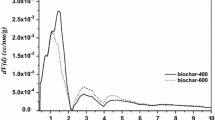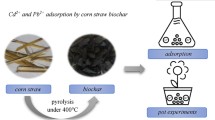Abstract
Biochar prepared from wheat straw (Triticum aestivum) at different pyrolysis temperatures was screened, followed by its application to soil for arsenic removal in the present study. Characterization of biochar by Field emission scanning electron microscope studies and Fourier thermal Infrared imaging showed smooth and porous biochar surface and abundance of surface functional groups. A low value of H/C was obtained by CHNS analyzer, indicating high stability of biochar. The surface area was 15.86 m2/g on an average. Batch sorption experiments were carried out to optimize conditions for arsenic sorption. Maximum arsenic removal of 83.7% was obtained when applied at a 7.5% dose for a contact time of 60 min at 25 °C. Isotherm, kinetic and thermodynamic studies revealed the feasibility of sorption and removal of arsenic through physisorption, chemisorption, ion exchange, and diffusion.



Similar content being viewed by others
References
Agrafioti E, Kalderis D, Diamadopoulos E (2014) Arsenic and chromium removal from water using biochars derived from rice husk, organic solid wastes and sewage sludge. J Environ Manage 133:309–314
Ahmad M, Rajapaksha AU, Lim JE et al (2014) Biochar as a sorbent for contaminant management in soil and water: a review. Chemosphere 99:19–33
Alam MO, Shaikh WA, Chakraborty S, Avishek K, Bhattacharya T (2016) Groundwater arsenic contamination and potential health risk assessment of gangetic plains of Jharkhand, India. Expo Health 8:125–142
Alam MA, Shaikh WA, Alam MO (2018) Adsorption of As(III) and As(V) from aqueous solution by modified Cassia fistula (golden shower) biochar. Appl Water Sci 8:1–14
Al-Haidarey MJS, Hassan FM, Al-Kubaisey ARA (2010) The Geoaccumulation Index of Some Heavy Metals in Al-Hawizeh Marsh. Iraq E-Journal Chem 7:839178
Armynah B, Tahir D, Tandilayuk M et al (2019) Potentials of biochars derived from bamboo leaf biomass as energy sources: effect of temperature and time of heating. Int J Biomater 2019:12–18
Ayawei N, Ebelegi AN, Wankasi D (2017) Modelling and interpretation of adsorption isotherms. J Chem 2017:3039817
Bakshi S, Banik C, He Z (2018) The impact of heavy metal contamination on soil health. In: Reicoskey D (ed) Managing soil health for sustainable agriculture. Taylor and Francis, Milton Park, pp 63–95
Beesley L, Marmiroli M (2011) The immobilisation and retention of soluble arsenic, cadmium and zinc by biochar. Environ Pollut 159:474–480
Beesley L, Marmiroli M, Pagano L et al (2013) Biochar addition to an arsenic contaminated soil increases arsenic concentrations in the pore water but reduces uptake to tomato plants (Solanum lycopersicum L.). Sci Total Environ 454–455:598–603
Břendová K, Tlustoš P, Száková J (2015) Can biochar from contaminated biomass be applied into soil for remediation purposes? Water Air Soil Pollut 226:1–12
Chen L, Chen Q, Rao P (2018) Formulating and optimizing a novel biochar-based fertilizer for simultaneous slow-release of nitrogen and immobilization of Cd. Sustainability 10:2740
Choong TSY, Chuah TG, Robiah Y et al (2007) Arsenic toxicity, health hazards and removal techniques from water: an overview. Desalination 217:139–166
Epa US (2007) METHOD 3051A: microwave assisted acid digestion of sediments, sludges, soils, and oils. Test Methods Eval Solid Waste Revision 1:1–30
Goswami R, Kumar M (2018) Removal of fluoride from aqueous solution using nanoscale rice husk biochar. Groundw Sustain Dev 7:446–451
Haris H, Looi LJ, Aris AZ (2017) Geo-accumulation index & contamination factors of heavy metals (Zn and Pb) in urban river sediment. Environ Geochem Health 39:1259–1271
Hina K, Abbas M, Hussain Q et al (2019) Investigation into arsenic retention in arid contaminated soils with biochar application. Arab J Geosci 12:671
Keiluweit M, Nico PS, Johnson M, Kleber M (2010) Dynamic molecular structure of plant biomass-derived black carbon (biochar). Environ Sci Technol 44:1247–1253
Kubier A, Wilkin RT, Pichler T (2019) Cadmium in soils and groundwater: a review. Appl Geochem 108:104388
Kumar A, Bhattacharya T (2020) Biochar: a sustainable solution. Environ Dev Sustain. https://doi.org/10.1007/s10668-020-00970-0
Kumar A, Bhattacharya T, Hasnain SMM, Nayak AK, Hasnain MS (2020) Applications of biomass-derived materials for energy production, conversion, and storage. Mater Sci Energy Technol 3:905–920
Kumaresan M, Riyazuddin P (2001) Overview of speciation chemistry of arsenic. Curr Sci 80:837–846
Kunzru S, Chaudhuri M (2005) Manganese amended activated alumina for adsorption/oxidation of arsenic. J Environ Eng 131:1350–1353
Mamindy-Pajany Y, Hurel C, Marmier N, Roméo M (2009) Arsenic adsorption onto hematite and goethite. Comptes Rendus Chim 12:876–881
Manna S, Singh N, Purakayastha TJ, Berns AE (2020) Effect of deashing on physico-chemical properties of wheat and rice straw biochars and potential sorption of pyrazosulfuron-ethyl. Arab J Chem 13:1247–1258
Marini Köpp M, Paixão Passos L, da Silva VR (2011) Effects of nutrient solution pH on growth parameters of alfalfa (Medicago sativa L.) genotypes. Commun Sci 2:135–141
Mohan D, Pittman CU Jr, Bricka M, Smith F, Yancey B, Mohammad J et al (2007) Sorption of arsenic, cadmium, and lead by chars produced from fast pyrolysis of wood and bark during bio-oil production. J Colloid Interface Sci 310(1):57–73
Naeem MA, Khalid M, Aon M et al (2017) Effect of wheat and rice straw biochar produced at different temperatures on maize growth and nutrient dynamics of a calcareous soil. Arch Agron Soil Sci 63:2048–2061
Pandey VC, Singh N (2015) Aromatic plants versus arsenic hazards in soils. J Geochem Explor 157:77–80
Pandey VC, Singh JS, Singh RP, Singh N, Yunus M (2011) Arsenic hazards in coal fly ash and its fate in Indian scenario. Resour Conserv Recycl 55:819–835
Park JH, Choppala G, Lee SJ et al (2013) Comparative sorption of Pb and Cd by biochars and its implication for metal immobilization in soils. Water Air Soil Pollut 224:1711
Praveen A, Pandey VC, Mehrotra S, Singh N (2019) Arsenic accumulation in Canna: effect on antioxidative defense system. Appl Geochem 108:104360
Raval NP, Kumar M (2021) Geogenic arsenic removal through core–shell based functionalized nanoparticles: groundwater in-situ treatment perspective in the post–COVID anthropocene. J Hazard Mater 402:123466
Roy A, Bhattacharya T, Kumari M (2020) Air pollution tolerance, metal accumulation and dust capturing capacity of common tropical trees in commercial and industrial sites. Sci Total Environ 722:137622
Sadaka S, Sharara MA, Ashworth A et al (2014) Characterization of biochar from switchgrass carbonization. Energies 7:548–567
Sari A, Tuzen M (2010) Biosorption of As(III) and As(V) from aqueous solution by lichen (Xanthoria parietina) biomass. Sep Sci Technol 45:463–471
Sari A, Ishak CF, Bakar RA (2014) Characterization of oil palm empty fruit bunch and rice husk biochars and their potential to adsorb arsenic and cadmium. Am J Agric Biol Sci 9:450–456
Shaikh WA, Alam MA, Alam MO, Chakraborty S, Owens G, Bhattacharya T, Mondal NK (2020) Enhanced aqueous phase arsenic removal by abiochar based iron nanocomposite. Environ Technol Innov 19:100936
Singh R, Singh S, Parihar P et al (2015) Arsenic contamination, consequences and remediation techniques: a review. Ecotoxicol Environ Saf 112:247–270
Singh B, Dolk MM, Shen Q, Camps-Arbestain M (2017) Biochar pH, electrical conductivity and liming potential. Biochar 14:23–38
Stella Mary G, Sugumaran P, Niveditha S et al (2016) Production, characterization and evaluation of biochar from pod (Pisum sativum), leaf (Brassica oleracea) and peel (Citrus sinensis) wastes. Int J Recycl Org Waste Agric 5:43–53
Sun L, Chen D, Wan S, Yu Z (2015) Performance, kinetics, and equilibrium of methylene blue adsorption on biochar derived from eucalyptus saw dust modified with citric, tartaric, and acetic acids. Bioresour Technol 198:300–308
Tabassum RA, Shahid M, Niazi NK et al (2019) Arsenic removal from aqueous solutions and groundwater using agricultural biowastes-derived biosorbents and biochar: a column-scale investigation. Int J Phytoremediation 21:509–518
Tavares D, Lopes C, Coelho J et al (2012) Removal of arsenic from aqueous solutions by sorption onto sewage sludge-based sorbent. Water Air Soil Pollut 223(5):2311–2321
Tchounwou PB, Yedjou CG, Patlolla AK, Sutton DJ (2012) Heavy metal toxicity and the environment. EXS 101:133–164
Tipayarom A, Kim Oanh NT (2020) Influence of rice straw open burning on levels and profiles of semi-volatile organic compounds in ambient air. Chemosphere 243:125379
Tirkey P, Bhattacharya T, Chakraborty S (2018) Optimization of fluoride removal from aqueous solution using Jamun leaf ash. Process Saf Environ Prot 115:125–138
Van Vinh N, Zafar M, Behera SK, Park HS (2015) Arsenic(III) removal from aqueous solution by raw and zinc-loaded pine cone biochar: equilibrium, kinetics, and thermodynamics studies. Int J Environ Sci Technol 12(4):1283–1294
Wan XM, Li C, Parikh S (2020) Simultaneous removal of arsenic, cadmium, and lead from soil by iron-modified magnetic biochar. Environ Pollut 261:114157
Wang S, Gao B, Zimmerman AR, Li Y et al (2015) Removal of arsenic by magnetic biochar prepared from pinewood and natural hematite. Bioresour Technol 175:391–395
Weber K, Quicker P (2018) Properties of biochar. Fuel 217:240–261
Wu W, Yang M, Feng Q et al (2012) Chemical characterization of rice straw-derived biochar for soil amendment. Biomass Bioenergy 47:268–276
Wu C, Cui MQ, Xue SG et al (2018) Remediation of arsenic-contaminated paddy soil by iron-modified biochar. Environ Sci Pollut Res 25:20792–20801
Yang Z, Fang Z, Zheng L et al (2016) Remediation of lead contaminated soil by biochar-supported nano-hydroxyapatite. Ecotoxicol Environ Saf 132:224–230
Zhang S, Abdalla MAS, Luo Z (2018) The wheat straw biochar research on the adsorption/ desorption behaviour of mercury in wastewater. Desalin Water Treat 112:147–160
Acknowledgements
The authors are thankful to the Central Instrumentation Facility and Department of Civil and Environmental Engineering, BIT Mesra for sample analysis. One of the authors (Abhishek Kumar) is grateful to the University Grants Commission, New Delhi, for providing NET-JRF Fellowship [Ref. No. - 3635/(OBC)(NET-DEC.2015)].
Author information
Authors and Affiliations
Corresponding author
Additional information
Publisher's Note
Springer Nature remains neutral with regard to jurisdictional claims in published maps and institutional affiliations
Rights and permissions
About this article
Cite this article
Kumar, A., Bhattacharya, T. Removal of Arsenic by Wheat Straw Biochar from Soil. Bull Environ Contam Toxicol 108, 415–422 (2022). https://doi.org/10.1007/s00128-020-03095-2
Received:
Accepted:
Published:
Issue Date:
DOI: https://doi.org/10.1007/s00128-020-03095-2




